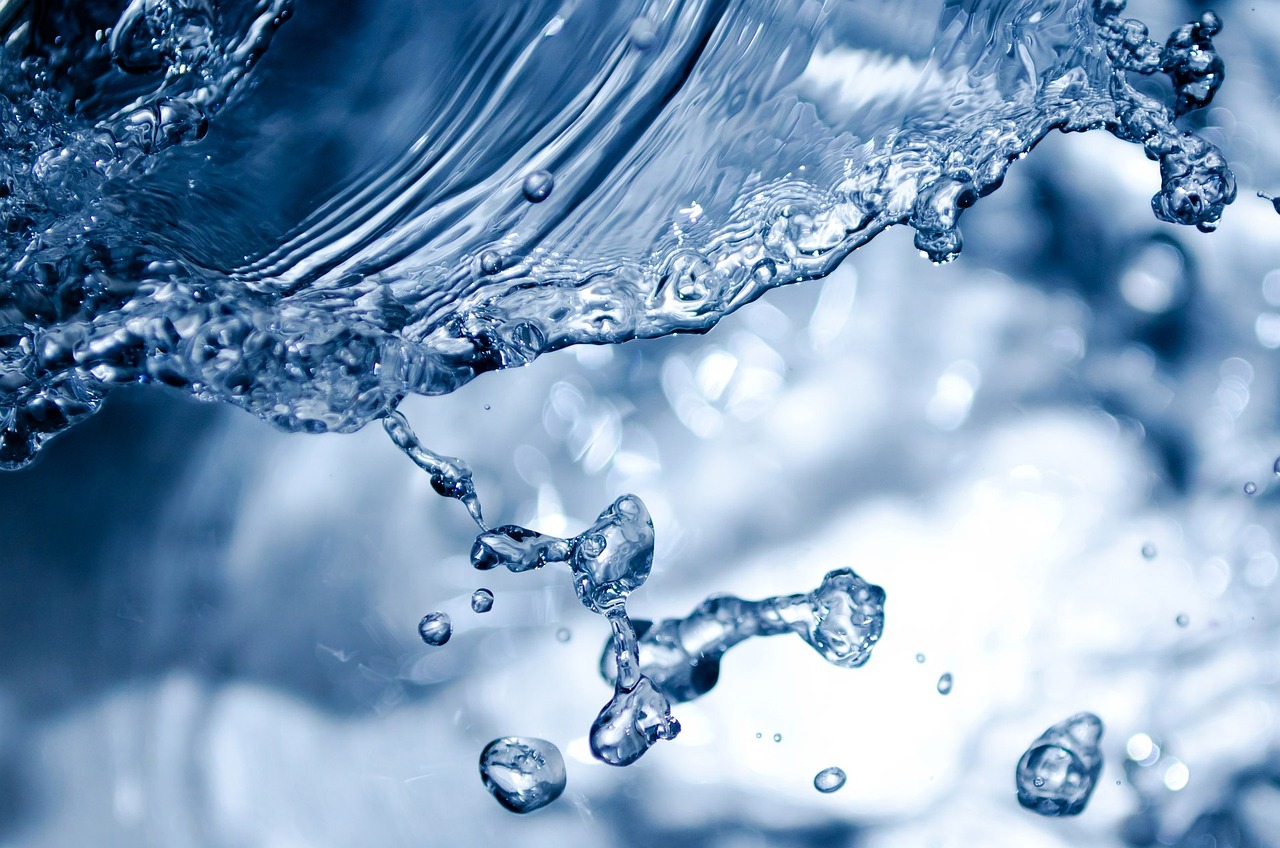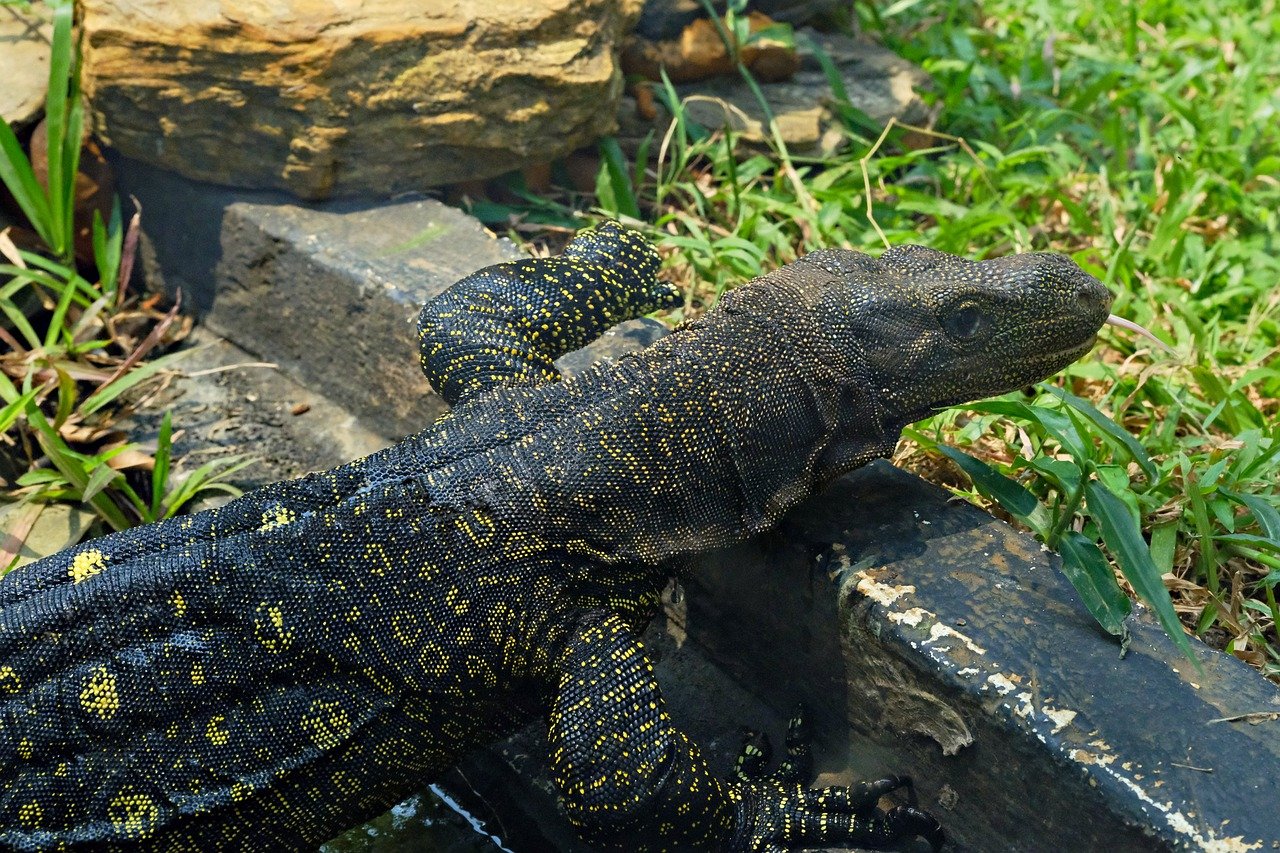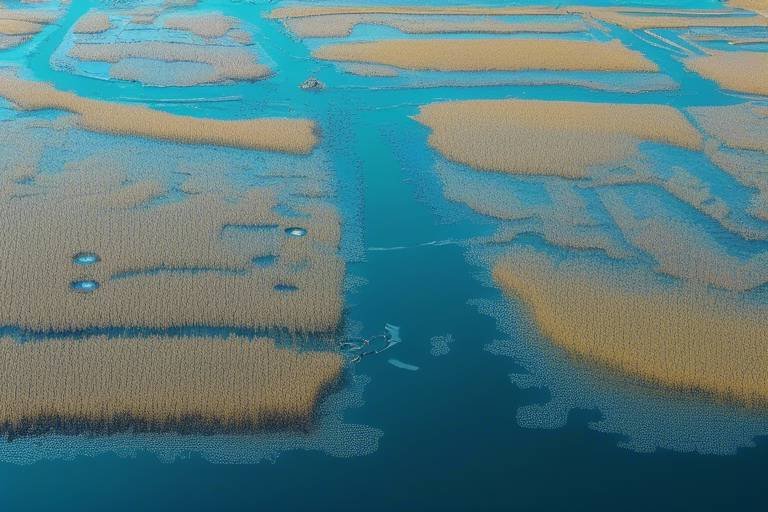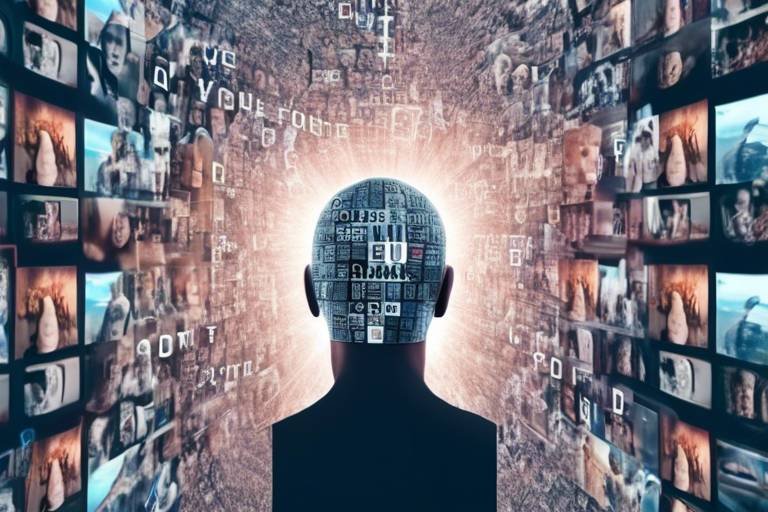Role of AI in Managing Water Quality
In today's world, where water is becoming an increasingly scarce resource, the role of artificial intelligence (AI) in managing water quality is nothing short of revolutionary. Imagine a world where we can predict water pollution before it happens, or where sensors can instantly alert us to contamination in our drinking water. Well, that world is not just a dream anymore; it’s happening right now! AI technologies are stepping in to transform how we monitor, analyze, and manage water quality, ensuring that we have safe and sustainable water resources for generations to come.
Water quality management has traditionally been a challenging field, plagued by issues such as pollution, climate change, and resource scarcity. These challenges can seem overwhelming, but with the power of AI, we can tackle them head-on. AI enables us to collect and analyze vast amounts of data, providing insights that were previously unimaginable. This leads to more informed decision-making and proactive strategies to protect our water sources.
One of the most exciting aspects of AI in water quality management is its ability to integrate various technologies. For instance, machine learning algorithms can sift through historical data and identify patterns that help predict future water quality fluctuations. This predictive capability is crucial for preventing potential crises before they escalate. Furthermore, AI-driven real-time monitoring systems can continuously track water quality parameters, allowing for immediate responses to contamination events. Think of it as having a vigilant guardian watching over our water supply, ready to spring into action at a moment's notice.
Moreover, remote sensing innovations powered by AI allow us to monitor large water bodies without the need for extensive physical sampling. This not only saves time and resources but also enhances our ability to assess water quality on a broader scale. The integration of these technologies is paving the way for a more sustainable approach to water management, one that prioritizes both efficiency and environmental health.
In conclusion, the role of AI in managing water quality is multifaceted and transformative. As we continue to face global water challenges, the innovative applications of AI will play a crucial role in ensuring that our water resources remain safe and sustainable. The future looks bright, and with AI at the helm, we can navigate the complexities of water quality management with confidence.
- How does AI improve water quality monitoring? AI improves water quality monitoring by enabling real-time data collection and analysis, allowing for quicker responses to contamination events.
- What are the benefits of predictive analytics in water management? Predictive analytics helps forecast potential water quality issues, allowing for timely remediation measures that protect public health and the environment.
- Can AI be used in agricultural water management? Yes, AI technologies can optimize irrigation systems by analyzing soil moisture and weather data, promoting efficient water use in agriculture.
- What role does remote sensing play in water quality assessment? Remote sensing technologies leverage AI to assess water quality from a distance, enhancing monitoring capabilities without extensive physical sampling.

Understanding Water Quality Challenges
Water quality management is a complex and multifaceted issue that is becoming increasingly critical in today's world. With the growing population and industrialization, our water resources are facing unprecedented pressures. One of the most pressing challenges is **pollution**, which can stem from various sources such as agricultural runoff, industrial discharges, and urban waste. This pollution not only affects the ecosystems but also poses serious health risks to humans. Imagine turning on your tap and wondering if the water is safe to drink—this is a reality for many communities around the globe.
Another significant challenge is **climate change**, which is altering precipitation patterns and increasing the frequency of extreme weather events. These changes can lead to flooding, which often results in the contamination of water supplies. For instance, heavy rains can wash pollutants into rivers and lakes, making it difficult to maintain clean water resources. Additionally, droughts can exacerbate the situation by concentrating contaminants in smaller water bodies, further compromising water quality.
Resource scarcity is yet another hurdle. As populations grow, the demand for fresh water is skyrocketing. Many regions are already experiencing water shortages, leading to conflicts over water rights and usage. This scarcity makes it imperative to manage our water resources wisely and sustainably. To illustrate, consider the following table that outlines some of the major challenges in water quality management:
| Challenge | Description |
|---|---|
| Pollution | Contamination from agricultural, industrial, and urban sources affecting ecosystems and human health. |
| Climate Change | Altered precipitation patterns leading to flooding and droughts, impacting water quality. |
| Resource Scarcity | Increased demand for fresh water leading to conflicts and unsustainable usage. |
Addressing these challenges requires a comprehensive understanding of the underlying issues and the implementation of effective strategies. This is where **artificial intelligence** comes into play. By analyzing vast amounts of data and identifying patterns, AI can help us tackle these challenges head-on. But before we dive into the solutions, it’s essential to recognize that the first step in managing water quality is understanding these complex challenges. Only then can we develop innovative technologies and strategies that ensure safe and sustainable water resources for future generations.
- What are the main sources of water pollution? Water pollution can originate from agricultural runoff, industrial discharges, and urban waste.
- How does climate change affect water quality? Climate change alters precipitation patterns, leading to flooding and droughts that can contaminate water supplies.
- Why is resource scarcity a concern for water quality? Increased demand for fresh water can lead to conflicts over water rights and unsustainable usage, impacting overall water quality.

AI Technologies in Water Quality Monitoring
In today's rapidly evolving technological landscape, artificial intelligence (AI) plays a pivotal role in transforming the way we monitor and manage water quality. Traditional water quality monitoring methods often involve labor-intensive sampling and analysis, which can be both time-consuming and costly. However, with the integration of AI technologies, we are witnessing a revolution in how water quality data is collected, analyzed, and acted upon. This shift not only enhances our ability to ensure safe drinking water but also promotes sustainable management of aquatic ecosystems.
One of the key technologies driving this change is machine learning. By utilizing algorithms that can learn from data, machine learning can identify complex patterns within vast datasets. This capability allows for the analysis of historical water quality data alongside real-time measurements, leading to more accurate predictions of water quality fluctuations. For instance, machine learning models can predict the likelihood of harmful algal blooms or other contamination events, enabling authorities to take proactive measures before these issues escalate.
Another significant advancement comes from real-time monitoring systems. These systems are equipped with sensors that continuously collect data on various water quality parameters, such as pH levels, turbidity, and the presence of pollutants. The integration of AI in these systems allows for immediate data analysis, which means that any anomalies can be detected and addressed almost instantaneously. Imagine a scenario where a sudden spike in contaminants is detected in a water supply; with AI-driven systems, responses can be initiated within minutes, significantly reducing the risk to public health.
Furthermore, remote sensing technologies are revolutionizing the way we monitor large water bodies. By using satellites and drones equipped with AI analytics, we can assess water quality from a distance, eliminating the need for extensive physical sampling. This method is particularly beneficial for monitoring remote or inaccessible areas, providing a comprehensive overview of water quality across vast regions. For example, remote sensing can be employed to monitor the health of lakes and rivers, identifying pollution sources and tracking changes over time.
To illustrate the impact of these technologies, consider the following table that summarizes the key AI technologies used in water quality monitoring:
| AI Technology | Application | Benefits |
|---|---|---|
| Machine Learning | Data analysis and prediction | Enhanced decision-making, early detection of issues |
| Real-time Monitoring Systems | Continuous data collection | Immediate response to contamination events |
| Remote Sensing | Assessment of large water bodies | Comprehensive monitoring without extensive sampling |
In conclusion, the integration of AI technologies in water quality monitoring is not just a trend; it is a necessary evolution in our approach to managing one of our most precious resources. By leveraging machine learning, real-time monitoring systems, and remote sensing, we are better equipped to tackle the challenges of water pollution and scarcity. As we continue to innovate and refine these technologies, the future of water quality management looks increasingly bright, ensuring that we can provide safe and sustainable water resources for generations to come.
- What is the role of AI in water quality management? AI helps in monitoring, analyzing, and predicting water quality issues, enabling faster responses to contamination.
- How does machine learning improve water quality monitoring? Machine learning analyzes large datasets to identify patterns and predict fluctuations in water quality.
- What are real-time monitoring systems? These systems continuously collect data on water quality parameters and provide immediate analysis for quick responses.
- How does remote sensing work in monitoring water quality? Remote sensing uses satellites and drones to assess water quality from a distance, allowing for extensive monitoring without physical sampling.

Machine Learning Applications
Machine learning is like the brain behind a lot of the innovations we see today, especially when it comes to managing water quality. Imagine having a super-smart assistant that can sift through mountains of data in the blink of an eye, spotting trends and predicting future events. That’s precisely what machine learning does! By analyzing vast datasets, machine learning algorithms can identify patterns that humans might overlook. For instance, consider a scenario where water quality fluctuates due to various factors such as rainfall, industrial discharge, or seasonal changes. Machine learning can help us understand these fluctuations by analyzing historical data and predicting how future conditions might affect water quality.
One of the standout features of machine learning in water quality management is its ability to enhance decision-making processes. This is crucial because timely decisions can mean the difference between a minor issue and a major crisis. For example, if a machine learning model detects an unusual spike in pollutants, it can alert water management authorities immediately. This proactive approach not only helps in pollution control but also ensures that water remains safe for consumption.
To illustrate the impact of machine learning applications, let's take a look at a few key areas where this technology is making waves:
- Data Analysis: Machine learning algorithms can process and analyze data from multiple sources, such as sensors, satellites, and historical records, providing a comprehensive view of water quality.
- Predictive Modeling: By predicting potential water quality issues, these models allow for early intervention, which is essential for protecting public health.
- Resource Optimization: Machine learning helps optimize the use of resources in water treatment plants, ensuring that operations are both cost-effective and environmentally friendly.
Furthermore, the integration of machine learning with other technologies such as the Internet of Things (IoT) amplifies its effectiveness. Smart sensors can continuously collect data on various water quality parameters, and machine learning algorithms can analyze this data in real-time. This synergy not only enhances monitoring capabilities but also enables swift responses to contamination events.
In summary, machine learning applications in water quality management are not just about crunching numbers; they represent a transformative approach to safeguarding our most vital resource. By harnessing the power of AI, we can make informed decisions that lead to cleaner, safer water for everyone. The potential is vast, and as technology continues to evolve, so too will our ability to protect and manage water quality effectively.

Predictive Analytics for Water Quality
Predictive analytics is like having a crystal ball for water quality management. It uses advanced algorithms and data analysis to forecast potential water quality issues before they become critical. Imagine being able to predict a storm's impact on a river's health or anticipating a rise in pollutants due to agricultural runoff. This proactive approach is not just a luxury; it's becoming a necessity in our rapidly changing world. By analyzing historical data alongside real-time inputs, AI can identify trends and patterns that might otherwise go unnoticed.
For instance, predictive analytics can help water managers understand how seasonal changes affect water quality. In the spring, when snow melts and rainfall increases, the risk of contaminants entering water systems rises. By utilizing AI, officials can prepare for these fluctuations, implementing measures to mitigate the impact on public health and the environment. This level of foresight is invaluable, as it allows for timely interventions that can save both resources and lives.
Furthermore, the application of predictive analytics can be enhanced by integrating various data sources, such as weather forecasts, land use patterns, and historical water quality records. For example, a table summarizing these data sources might look like this:
| Data Source | Description |
|---|---|
| Weather Data | Forecasts and historical weather patterns that influence water quality. |
| Land Use Data | Information on agricultural, urban, and industrial activities affecting water sources. |
| Water Quality Records | Historical data on water quality parameters, such as pH, turbidity, and contaminant levels. |
By leveraging these diverse datasets, predictive models can be fine-tuned to provide more accurate forecasts. This not only enhances decision-making but also fosters a culture of preparedness among water management authorities. The ability to predict potential crises means that resources can be allocated more efficiently, ensuring that communities are safeguarded against waterborne threats.
In conclusion, predictive analytics is transforming the landscape of water quality management. It's not just about reacting to problems; it's about anticipating them. As we continue to harness the power of AI and data analytics, the future of water quality looks brighter, paving the way for a more sustainable and resilient approach to managing one of our most precious resources.
- What is predictive analytics in water quality management?
Predictive analytics involves using data analysis and algorithms to forecast potential water quality issues before they occur, allowing for proactive management strategies. - How does AI enhance predictive analytics?
AI improves predictive analytics by analyzing vast amounts of data from various sources, identifying patterns, and making accurate predictions about future water quality scenarios. - Why is predictive analytics important for public health?
By predicting water quality issues, authorities can implement timely interventions, reducing the risk of waterborne diseases and ensuring safe drinking water for communities. - Can predictive analytics be used in rural areas?
Absolutely! Predictive analytics can be applied in any context, including rural areas, where it can help manage water resources more effectively and sustainably.

Real-time Monitoring Systems
In today's rapidly changing world, have emerged as a game-changer in managing water quality. Imagine having the ability to keep an eye on water bodies as if they were under a constant watchful eye, detecting changes in quality at the speed of light. These systems utilize advanced AI technologies to collect and analyze data continuously, allowing for immediate responses to any irregularities. This proactive approach is essential for safeguarding not only public health but also the delicate ecosystems that depend on clean water.
One of the most significant advantages of real-time monitoring systems is their ability to provide instantaneous feedback on various water quality parameters, such as pH levels, turbidity, dissolved oxygen, and contaminant concentrations. By employing sensors and IoT devices, these systems can transmit data in real-time, enabling water management authorities to act swiftly. For instance, if a sudden spike in contamination is detected, alerts can be sent out immediately, prompting remediation efforts before the situation escalates.
Moreover, the integration of AI into these monitoring systems enhances their capabilities. Machine learning algorithms can analyze historical data alongside real-time inputs, identifying trends and predicting potential issues before they occur. This predictive capability not only aids in compliance with environmental regulations but also helps in resource allocation, ensuring that interventions are targeted where they are most needed. The following table illustrates the key features of real-time monitoring systems:
| Feature | Description |
|---|---|
| Continuous Data Collection | Real-time sensors gather data on water quality parameters without interruption. |
| Instant Alerts | Immediate notifications are sent out in case of contamination or parameter deviations. |
| Data Analysis | AI algorithms analyze both real-time and historical data to predict trends. |
| Remote Accessibility | Data can be accessed remotely, allowing for efficient monitoring from anywhere. |
Furthermore, the implementation of these systems can be seen in various sectors, including municipal water supply, industrial discharges, and agricultural runoff. For example, cities are increasingly adopting AI-driven monitoring networks to ensure that drinking water remains safe and free from pollutants. This not only protects the health of residents but also builds trust within the community regarding the quality of their water supply.
In agriculture, real-time monitoring systems are revolutionizing irrigation practices. By using data from these systems, farmers can optimize water usage, ensuring that crops receive the right amount of water without wastage. This not only enhances crop yield but also conserves precious water resources, showcasing the dual benefits of these advanced technologies.
In conclusion, real-time monitoring systems powered by AI are paving the way for a future where water quality management is more efficient and responsive. The combination of continuous data collection, instant alerts, and advanced analytics enables authorities to tackle water quality challenges head-on, ensuring that our water resources remain safe and sustainable for generations to come.
- How do real-time monitoring systems work? They use sensors and IoT devices to continuously collect data on water quality and transmit it for analysis.
- What parameters can real-time monitoring systems track? They can track various parameters including pH levels, turbidity, dissolved oxygen, and contamination levels.
- Why is real-time monitoring important? It allows for immediate response to water quality issues, protecting public health and the environment.
- Can real-time monitoring systems be used in agriculture? Yes, they help optimize irrigation by analyzing soil moisture and weather data.

Remote Sensing Innovations
In the realm of water quality management, are making waves—quite literally! This cutting-edge technology utilizes satellite imagery and aerial data collection to assess water quality from afar, eliminating the need for extensive physical sampling. Imagine being able to monitor vast lakes, rivers, and reservoirs without having to dip a toe in the water; that’s the magic of remote sensing! By harnessing the power of artificial intelligence, these innovations enable us to gather and analyze data on various water quality parameters, such as temperature, turbidity, and chlorophyll concentrations.
One of the most remarkable aspects of remote sensing is its ability to cover large geographical areas quickly. Traditional methods of water quality testing can be labor-intensive and time-consuming, often requiring teams of scientists to physically collect samples. In contrast, remote sensing allows for real-time monitoring and rapid assessment of water conditions, which is essential for timely interventions, especially in cases of pollution or contamination events. For instance, during a harmful algal bloom, remote sensing can detect changes in water color and clarity, alerting authorities to take immediate action.
Moreover, remote sensing technologies can integrate data from multiple sources, providing a comprehensive view of water quality across different regions. This capability is particularly beneficial for environmental monitoring and policy-making. By analyzing satellite data alongside ground-based measurements, researchers can create more accurate models of water quality trends over time. The following table summarizes some key parameters that can be monitored using remote sensing:
| Parameter | Description | Importance |
|---|---|---|
| Temperature | Surface temperature of water bodies | Affects aquatic life and chemical processes |
| Turbidity | Cloudiness or haziness of water | Indicates the presence of pollutants |
| Chlorophyll Concentration | Indicator of phytoplankton biomass | Helps assess ecosystem health |
| pH Levels | Acidity or alkalinity of water | Essential for maintaining aquatic life |
As we look to the future, the integration of remote sensing with other AI technologies promises even greater advancements in water quality management. Imagine a world where predictive models can forecast water quality issues before they occur, all thanks to the continuous stream of data provided by remote sensing systems. The potential for safeguarding our water resources has never been more exciting, and it’s all happening right above our heads!
- What is remote sensing? Remote sensing is the acquisition of information about an object or phenomenon without making physical contact, often using satellite or aerial imagery.
- How does remote sensing help in water quality management? It allows for real-time monitoring of water bodies, providing valuable data on various water quality parameters without the need for extensive physical sampling.
- What are some limitations of remote sensing? While remote sensing is powerful, it may not capture certain localized pollution events and can be affected by atmospheric conditions.
- Can remote sensing be used for all types of water bodies? Yes, remote sensing can be applied to oceans, rivers, lakes, and even man-made reservoirs, providing a broad perspective on water quality.

Case Studies of AI Implementation
The integration of artificial intelligence in water quality management is not just theoretical; it's happening in real-world scenarios across the globe. These case studies provide compelling evidence of how AI is transforming the way we monitor and manage our precious water resources. From urban environments to agricultural landscapes, AI is proving to be an invaluable ally in the quest for cleaner and safer water.
One notable example can be found in Barcelona, Spain, where the city has implemented an AI-driven system to monitor its water supply network. This system leverages machine learning algorithms to analyze data from various sensors installed throughout the city. By identifying patterns and anomalies in water flow and quality, the system can predict potential leaks or contamination events before they escalate. The result? A significant reduction in water loss and improved public health outcomes.
In Singapore, the government has turned to AI for its innovative approach to managing stormwater. The city-state experiences heavy rainfall, which can lead to flooding and water pollution. By utilizing AI algorithms that analyze real-time weather data, soil moisture levels, and historical rainfall patterns, Singapore has developed a predictive model that optimizes its drainage systems. This proactive management strategy not only enhances the city's resilience to flooding but also ensures that water quality remains high during heavy rains.
Another fascinating case is seen in California, USA, where AI is being used to enhance agricultural water use. Farmers are now employing AI technologies that analyze soil moisture data and weather forecasts to optimize irrigation schedules. This approach ensures that crops receive the right amount of water at the right time, leading to improved yields while conserving water resources. As a result, California's farmers are not only increasing their productivity but also contributing to sustainable water management practices.
To further illustrate the impact of AI on water quality management, let's take a look at some key metrics from these case studies:
| Location | AI Application | Outcome |
|---|---|---|
| Barcelona, Spain | Leak detection and water quality monitoring | Reduced water loss and improved public health |
| Singapore | Stormwater management and predictive modeling | Enhanced flood resilience and maintained water quality |
| California, USA | Agricultural irrigation optimization | Increased crop yield and conservation of water |
These examples showcase the versatility and effectiveness of AI technologies in addressing various challenges associated with water quality management. By harnessing the power of data analytics and machine learning, cities and agricultural sectors are not only enhancing their operational efficiency but also paving the way for a more sustainable future.
- What is the role of AI in water quality management?
AI helps in monitoring, predicting, and improving water quality by analyzing large datasets and providing real-time insights. - How does predictive analytics work in water management?
Predictive analytics uses historical data and machine learning algorithms to forecast potential water quality issues, allowing for proactive measures. - Can AI help in agricultural water use?
Yes, AI technologies optimize irrigation systems by analyzing soil moisture and weather data, promoting efficient water use in agriculture. - What are some successful case studies of AI in water management?
Examples include Barcelona's leak detection system, Singapore's stormwater management, and California's agricultural irrigation optimization.

Urban Water Management
In the bustling heart of our cities, where skyscrapers touch the clouds and millions of people converge, the management of water resources becomes a critical priority. Urban water management is not just about providing clean drinking water; it’s about ensuring the sustainability of our precious resources amid increasing demand and environmental challenges. Artificial Intelligence (AI) is stepping in as a game-changer, revolutionizing how we approach these challenges. Imagine a world where water treatment processes are optimized in real-time, where data-driven decisions lead to reduced waste, and where compliance with regulatory standards is no longer a daunting task but a seamless part of operations.
One of the most significant advancements in urban water management is the implementation of smart water systems. These systems utilize AI algorithms to analyze data from various sources, including sensors placed throughout the water supply network. By monitoring parameters such as flow rates, pressure, and contamination levels, these systems can detect anomalies and predict potential issues before they escalate. For instance, if a sudden drop in pressure is detected, it could indicate a leak or a burst pipe, prompting immediate investigation and remediation.
Moreover, AI-driven predictive analytics play a pivotal role in optimizing water treatment processes. By examining historical data and current trends, AI can forecast demand fluctuations, allowing water utilities to adjust their operations accordingly. This capability not only enhances efficiency but also significantly reduces operational costs. For example, a city that anticipates a spike in water demand due to an upcoming festival can proactively increase treatment capacity and ensure that supply meets the heightened demand.
Additionally, urban areas are increasingly vulnerable to the impacts of climate change, including extreme weather events and shifting rainfall patterns. Here, AI can aid in developing resilient water management strategies. By utilizing machine learning models that analyze climate data, cities can better prepare for potential water shortages or flooding scenarios. This proactive approach enables local governments to implement measures such as rainwater harvesting or enhanced drainage systems, ultimately safeguarding public health and the environment.
Furthermore, the integration of AI technologies in urban water management extends to community engagement. Smart applications can provide residents with real-time information about their water usage, quality, and conservation tips. This transparency not only fosters a sense of responsibility among consumers but also encourages them to adopt more sustainable practices. For example, a mobile app could notify users about peak usage times, prompting them to adjust their water consumption habits accordingly.
As cities continue to grow and evolve, the need for innovative solutions in water management becomes ever more pressing. AI is not merely a tool; it is a vital partner in the quest for sustainable urban water management. By harnessing the power of AI, we can ensure that our cities not only thrive but also protect our most vital resource—water.
- What is urban water management? Urban water management refers to the planning, development, and management of water resources in urban areas to ensure a sustainable supply of water for drinking, sanitation, and other uses.
- How does AI improve water quality management? AI enhances water quality management by providing real-time data analysis, predictive modeling, and automated monitoring systems that help identify and address potential issues quickly.
- What are smart water systems? Smart water systems are integrated technologies that use sensors and AI algorithms to monitor and manage water supply networks efficiently, reducing waste and improving service delivery.
- Can AI help in climate change adaptation for urban water systems? Yes, AI can analyze climate data to forecast water supply challenges and help cities implement adaptive strategies to mitigate the impacts of climate change.

Agricultural Water Use
Agriculture is the backbone of our food supply, but it’s also one of the largest consumers of freshwater resources. With the global population on the rise, the demand for food is skyrocketing, leading to an increased pressure on water resources. This is where artificial intelligence (AI) comes into play, revolutionizing the way we manage agricultural water use. Imagine a world where farmers can optimize their water usage, ensuring crops receive just the right amount of moisture while conserving precious water resources. Sounds like a dream, right? Well, it's becoming a reality!
AI technologies, particularly in the realm of data analysis and machine learning, are enabling farmers to make informed decisions about irrigation. For instance, by analyzing data from various sources such as soil moisture sensors, weather forecasts, and historical crop performance, AI can predict the optimal time to irrigate. This not only helps in conserving water but also enhances crop yield, making farming more sustainable.
One fascinating application of AI in agriculture is the use of smart irrigation systems. These systems utilize real-time data to adjust water application based on the specific needs of the crops. For example, if a rainstorm is forecasted, the system can delay irrigation, preventing overwatering and runoff. This dynamic approach to water management is crucial in a world where water scarcity is becoming a pressing issue.
Moreover, AI can help farmers identify drought stress in crops before it becomes visible to the naked eye. By analyzing satellite imagery and other remote sensing data, AI algorithms can detect subtle changes in plant health, allowing farmers to take corrective actions promptly. This early intervention can make a significant difference in crop survival and yield, ultimately benefiting both farmers and consumers.
To better illustrate the impact of AI on agricultural water use, consider the following table showcasing the benefits:
| Benefit | Description |
|---|---|
| Water Conservation | AI helps optimize irrigation schedules, reducing water waste. |
| Increased Efficiency | Smart systems enable precise water application based on real-time data. |
| Enhanced Crop Yields | Timely interventions lead to healthier crops and better harvests. |
| Cost Savings | Reduced water usage translates to lower utility costs for farmers. |
In addition to these benefits, AI technologies are also paving the way for more sustainable agricultural practices. By promoting efficient water use, farmers can minimize their environmental impact, contributing to a healthier ecosystem. As we continue to face challenges related to climate change and water scarcity, the integration of AI in agricultural water management will be crucial for ensuring food security and sustainability.
In conclusion, the role of AI in agricultural water use is not just a trend but a necessity. By harnessing the power of technology, farmers can make smarter decisions that benefit their crops, their wallets, and the environment. So, the next time you enjoy a fresh salad or a delicious piece of fruit, remember that AI might just have played a part in bringing it to your table!
- How does AI improve irrigation practices?
AI analyzes data from various sources to determine the optimal irrigation schedule, reducing water waste and improving crop health. - What are smart irrigation systems?
These are automated systems that use real-time data to adjust water application based on the specific needs of crops. - Can AI help in drought management?
Yes, AI can detect drought stress in crops early, allowing for timely interventions to save water and crops. - What are the environmental benefits of using AI in agriculture?
AI promotes efficient water use, which helps conserve resources and reduce the environmental impact of farming.

The Future of AI in Water Quality Management
The future of AI in water quality management is not just bright; it's practically glowing with potential! As we look ahead, the integration of advanced technologies and innovative data analytics is set to redefine how we approach one of our planet's most critical resources: water. Imagine a world where artificial intelligence not only helps us monitor water quality but also actively prevents contamination before it becomes a crisis. This is not a distant dream; it's rapidly becoming a reality.
With the ongoing advancements in machine learning and predictive analytics, the capability to analyze complex datasets is becoming more refined. These technologies allow us to identify trends and anomalies in water quality data, leading to more informed decision-making. For instance, AI can predict when a water source is likely to become polluted based on historical data, seasonal changes, and even social factors like population growth. This proactive approach ensures that we can take action before problems escalate, safeguarding both public health and the environment.
Moreover, the rise of IoT (Internet of Things) devices is revolutionizing real-time monitoring. Imagine sensors deployed across lakes, rivers, and treatment plants, continuously gathering data on various water quality parameters such as pH levels, turbidity, and contaminants. These sensors can communicate with AI systems that analyze the data instantaneously, enabling swift responses to any detected anomalies. The ability to respond in real-time means that contamination events can be addressed immediately, minimizing the impact on ecosystems and human populations.
As we delve deeper into the future, we can expect to see a surge in collaborative efforts between governments, tech companies, and environmental organizations. By pooling resources and expertise, we can develop comprehensive AI solutions tailored to specific regional challenges. For example, smart water management systems could be implemented in urban areas, optimizing water distribution and treatment processes while reducing waste. In agricultural settings, AI can help farmers use water more efficiently, ensuring that crops receive the right amount of moisture while conserving this precious resource.
To illustrate the potential impact of AI in water quality management, consider the following table that outlines key benefits:
| Benefit | Description |
|---|---|
| Proactive Management | AI can predict potential water quality issues, allowing for timely interventions. |
| Enhanced Monitoring | Real-time data collection leads to immediate responses to contamination events. |
| Resource Optimization | AI helps optimize water use in agriculture and urban settings, reducing waste. |
| Collaboration | Joint efforts can lead to tailored solutions for specific regional challenges. |
However, with such advancements come challenges that we must address. Issues such as data privacy, the need for robust infrastructure, and the requirement for skilled personnel to manage these technologies are paramount. It's crucial that we tackle these challenges head-on to fully realize the benefits that AI can bring to water quality management.
In conclusion, the future of AI in water quality management is not just about technology; it's about creating a sustainable future for our planet. By harnessing the power of AI, we can ensure that our water resources are protected and managed efficiently, paving the way for a cleaner, healthier world for generations to come.
- How does AI improve water quality monitoring? AI enhances monitoring by analyzing large datasets in real-time, allowing for quicker detection of issues.
- What are the main challenges of implementing AI in water management? Challenges include data privacy concerns, infrastructure requirements, and the need for skilled workforce.
- Can AI predict water quality issues before they occur? Yes, AI uses predictive analytics to forecast potential problems based on historical data.
- What role do IoT devices play in water quality management? IoT devices collect real-time data on water quality, which AI systems analyze for immediate response.
Frequently Asked Questions
- What is the role of AI in managing water quality?
AI plays a transformative role in managing water quality by utilizing innovative technologies to analyze data, predict trends, and monitor water conditions in real-time. This helps in making informed decisions to ensure safe and sustainable water resources.
- What are the main challenges in water quality management?
Water quality management faces significant challenges such as pollution from industrial and agricultural sources, the impacts of climate change, and scarcity of clean water resources. These issues necessitate effective monitoring and management solutions, where AI can be a game-changer.
- How does machine learning contribute to water quality monitoring?
Machine learning algorithms analyze large datasets to identify patterns and predict fluctuations in water quality. This capability enhances decision-making processes, allowing for better pollution control and more effective water management strategies.
- What is predictive analytics and how is it used in water quality management?
Predictive analytics uses AI to forecast potential water quality issues before they occur. By anticipating problems, stakeholders can implement timely remediation measures, thereby protecting public health and the environment.
- What are real-time monitoring systems and their benefits?
AI-driven real-time monitoring systems continuously collect and analyze data on water quality parameters. These systems enable immediate responses to contamination events, ensuring quicker mitigation actions and enhancing overall water safety.
- How does remote sensing improve water quality assessment?
Remote sensing technologies, when combined with AI, allow for the assessment of water quality from a distance. This method is particularly beneficial for monitoring large water bodies without extensive physical sampling, making it more efficient and cost-effective.
- Can you provide examples of AI implementation in urban water management?
In urban areas, AI has been used to optimize water treatment processes, reduce waste, and improve compliance with regulatory standards. These applications lead to enhanced efficiency and better resource management.
- How is AI used in agricultural water management?
AI technologies in agriculture help manage irrigation systems by analyzing soil moisture levels and weather data. This promotes efficient water use, improves crop yields, and minimizes environmental impact, creating a sustainable approach to farming.
- What does the future hold for AI in water quality management?
The future of AI in water quality management looks bright, with ongoing advancements in technology and data analytics. These developments promise to deliver more sustainable and effective solutions to global water challenges, ensuring better management of this vital resource.



















